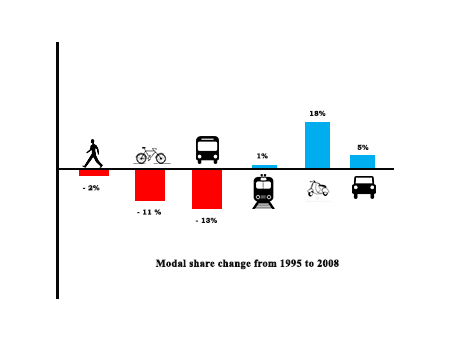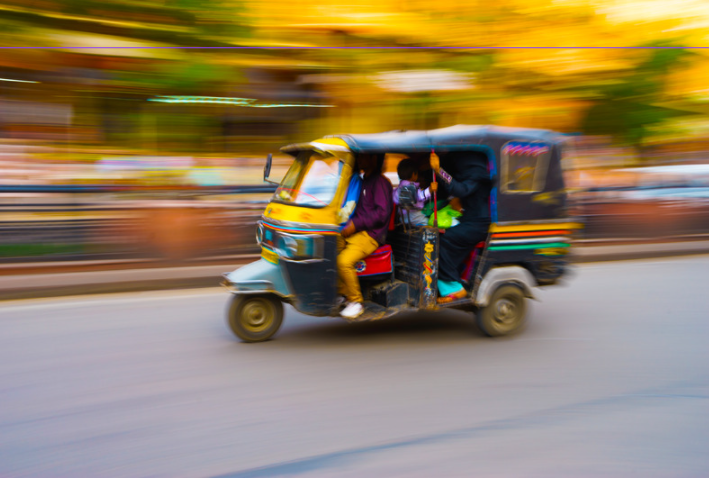Urbanization in India was at a high of 31.16% between 2001 and 2011 (Census of India, 2011). This rapid urbanization is reflected at the local level - Tamil Nadu is one of the most urbanized states with 44% of people living in cities like Chennai (Census of India, 2011). Unfortunately, this has also meant that cities have become very crowded, polluted spaces where everything is at a premium - education, housing, transport, food, water - the list goes on. Certainly living in a city is not a pleasant experience! This begs the question, what do we want from our cities and how are we going to achieve it?
A liveable city would be green, clean, with adequate housing, education, food, water, sanitation for all. It would also be sustainable in that it would not consume more resources than can be replenished by Nature. Another important component would be to ensure everyone in the city has access to affordable transportation. (The pandemic showed us how important transport is to our lives!)
So in a liveable city, we would want our transport to be affordable, safe, clean, eco-friendly, and accessible for all. Walking, cycling, and public transport (bus, train, Metro, share autos) tick all of these boxes but looking at Chennai’s transportation scenario, we see that these modes of mobility are not popular and most people are moving to personal vehicles (bikes and cars).

Fig 1: Modal share change for Chennai between 1995 and 2008
Why are people abandoning these sustainable modes of mobility? Because the city has been prioritizing private transport over public transport by widening roads, building flyovers to ease congestion, allowing cars and bikes to be parked anywhere (including on pavements), not cracking down on encroachments (parked vehicles, shops, garbage etc) on pavements, etc. At the same time, money and effort in improving public transport has come down - the city’s bus fleet has reduced instead of increasing, for example. Other long term problems have not been addressed. If a person wants to use public transport in Chennai, there is a lack of easily available information on fares, routes, frequency; every public transit system (i.e bus or train) has separate ticketing so switching from one to another is a pain. And finally, there is the issue of first and last mile connectivity or in plain English, the problem of getting to and from a bus stop or train station to our destination which often requires walking in the hot sun in the middle of traffic! No wonder people are abandoning public transport.
This may seem like a complex issue but if we break it down into smaller components it is doable. Lets take for example the problem of first and last mile connectivity. A solution to this is intermediate paratransit or in other words - share autos.
Share autos can help a commuter reach the public transport network as they are fast, inexpensive, and reliable, and great for short-distance commutes acting like a feeder system (bringing commuters to the bus and train network). World over, such systems are recognised as an important part of the transport network. Chennai has 60,000 share autos but unfortunately they do not serve as a feeder system, but instead compete with Metropolitan Transport Corporation (MTC) by running on the same routes as MTC.

What ails share autos in Chennai?
While speaking to share auto drivers, we understood that they run on the same routes as the buses because that is where the passengers are. They were not sure they would make money if they had to roam around residential areas hoping for people to get in to reach the main road. Even competing with MTC, a share auto driver takes home just Rs 500 per day which is hardly enough to run a family.
Then they said they were given the ‘wrong permit’. Delving into this we found that under the Motor Vehicles Amendment Act, 2019, commercial vehicles must have one of two permits - stage or contract carriage. Stage carriage permit is meant for vehicles that stop at various points on a route to pick up and drop people off such as public buses, while contract carriage is for vehicles that provide a point-to-point service such as autos and taxis. Oddly, share autos are issued contract carriage permits although they pick up and drop off passengers at various points.
We then asked an official in the transport department (which is responsible for policies on transport and also for issuing licenses and permits for vehicles) why this was and he shared that this was a decision taken by the state government years ago because the concern was that share autos would compete with buses. Hence, only about 100 share auto permits are issued in Chennai every year. With 60,000 share autos plying, a permit is in high demand leading to permits being sold illegally. An interview with the share auto union leader revealed that the price of permits can go to lakhs in the black market.
The way forward
With the formation and operationalisation of the inter-agency government transport authority, CUMTA (Chennai Unified Metropolitan Transport Authority), we hope the government recognises that share autos are an integral part of the city’s transportation network and works to remove the hurdles that stop share autos from being an useful and efficient paratransit system. For this the government must:
- Perspective shift: A change in the government’s approach to share autos is crucial. Instead of seeing shared autos as a threat to the MTC service, the government should see them as a feeder service for public transit. To ensure share autos fill that gap, the financial feasibility of running share autos as a feeder network needs to be looked into. The demand for feeder services in residential, commercial, and institutional areas needs to be analyzed before implementation. The government can learn from the Philippines experience where jeepneys (converted trucks) ply like share autos. In an effort to bring order to the system, steps were taken by the Philippines transport authorities to regularize jeepneys. All jeepney drivers are now required to have a special license. To make jeepneys more accessible and to minimize road crashes, fixed jeepney stops were established. Such jeepney stops helped to improve traffic flow, reduced the emissions caused by stop-and-go traffic and improved road safety. Regularizing the share auto systems can pay rich dividends as it can then grow to support the existing public transport system.
- Permits: A part of this regularization should involve issuing the appropriate permits to share autos - a stage carriage permit. It goes without saying that the number of permits issued should go up drastically, based on the demand.
- Information systems: In addition, standardizing fare rates and creating route maps will help increase efficiency and attract more passengers into the public transit network. This will have a cascading effect of reduced traffic congestion, pollution, and road crashes, as more people shift to public transit.
With so many benefits that can be obtained from regulating share autos, authorities need to look into formalizing it, expanding it and better integrating it into the existing network. The share auto union says it is more than ready to come to the table and iron out problems with the government. The question is will the government respond positively?